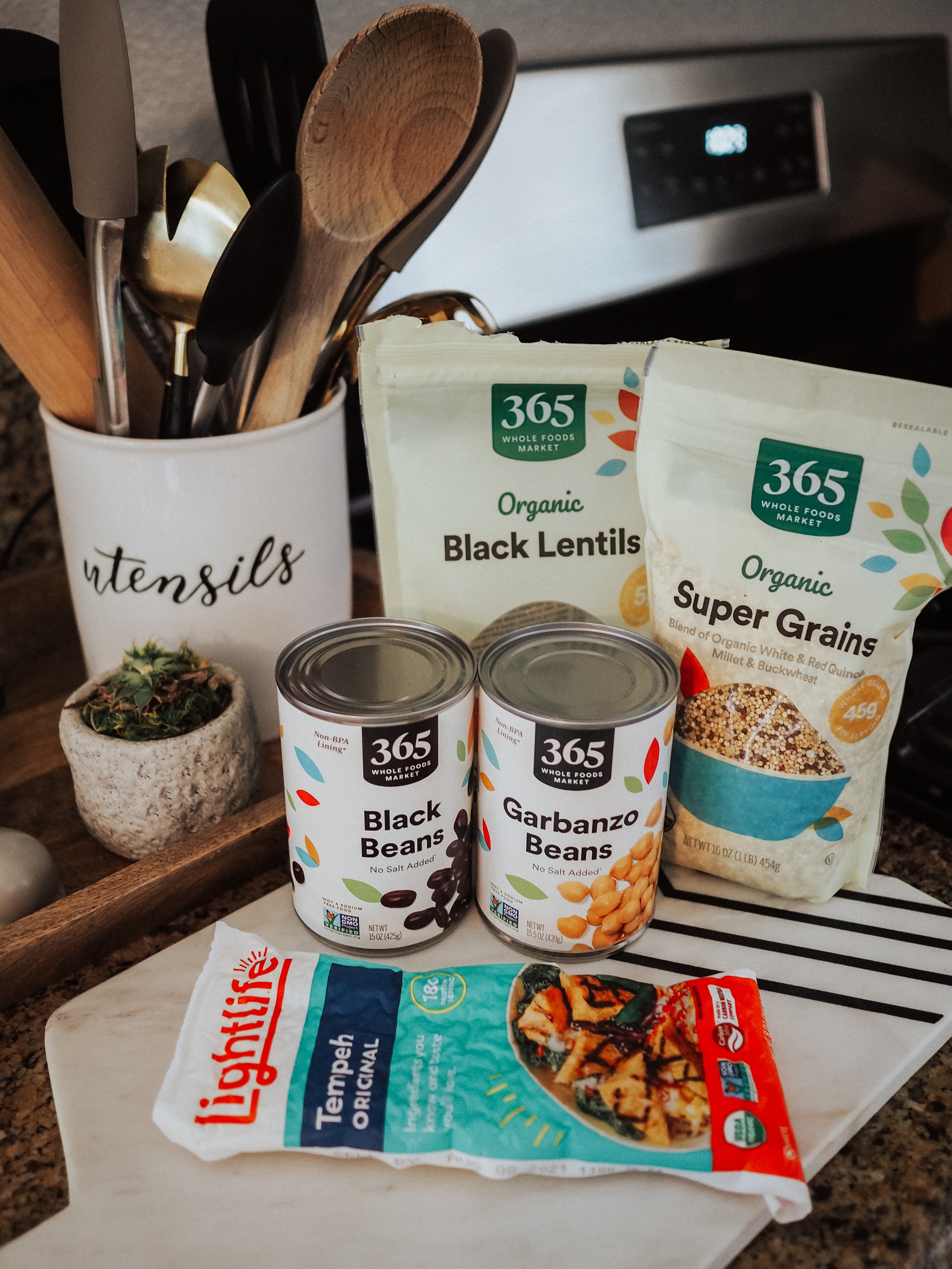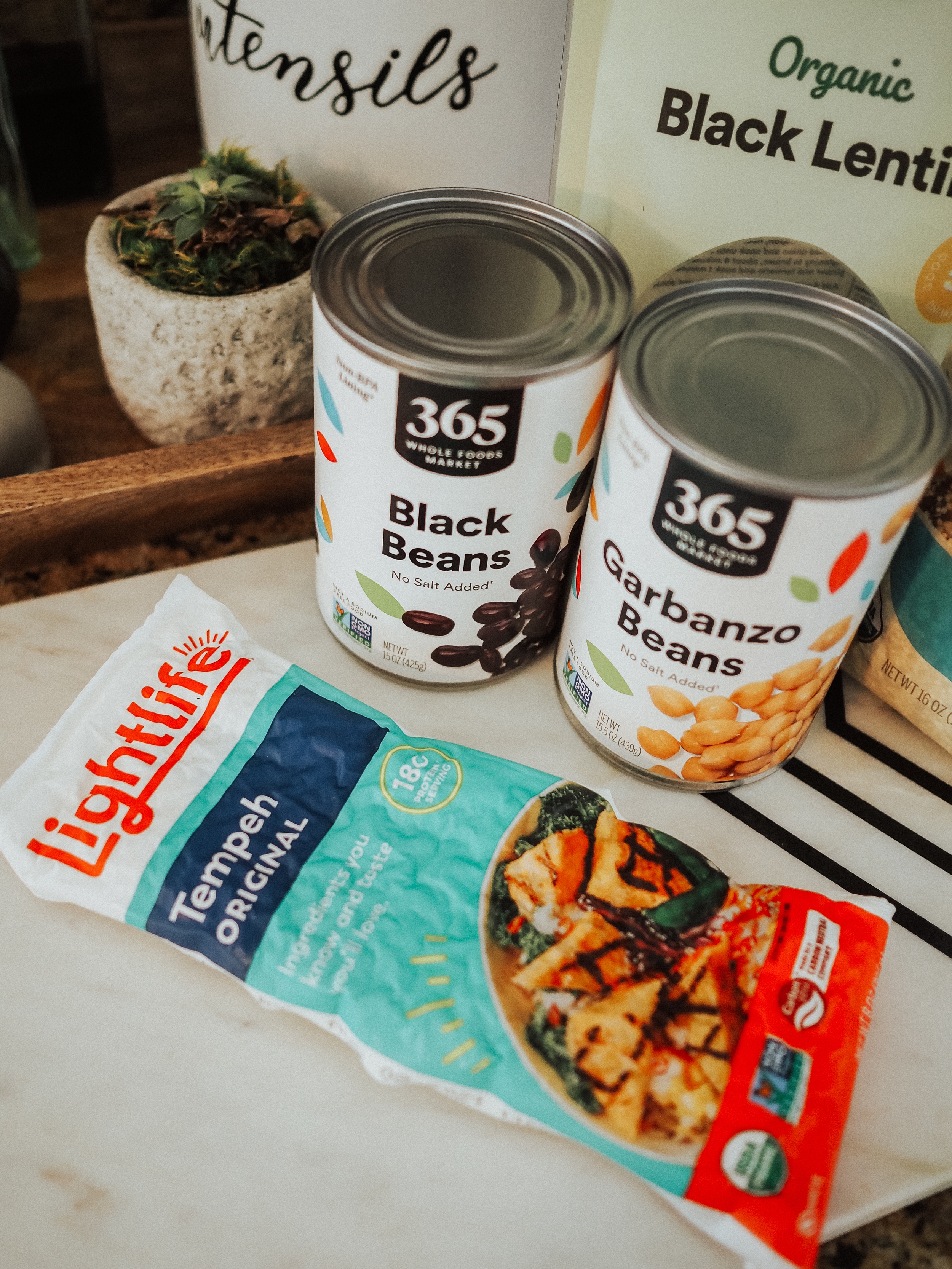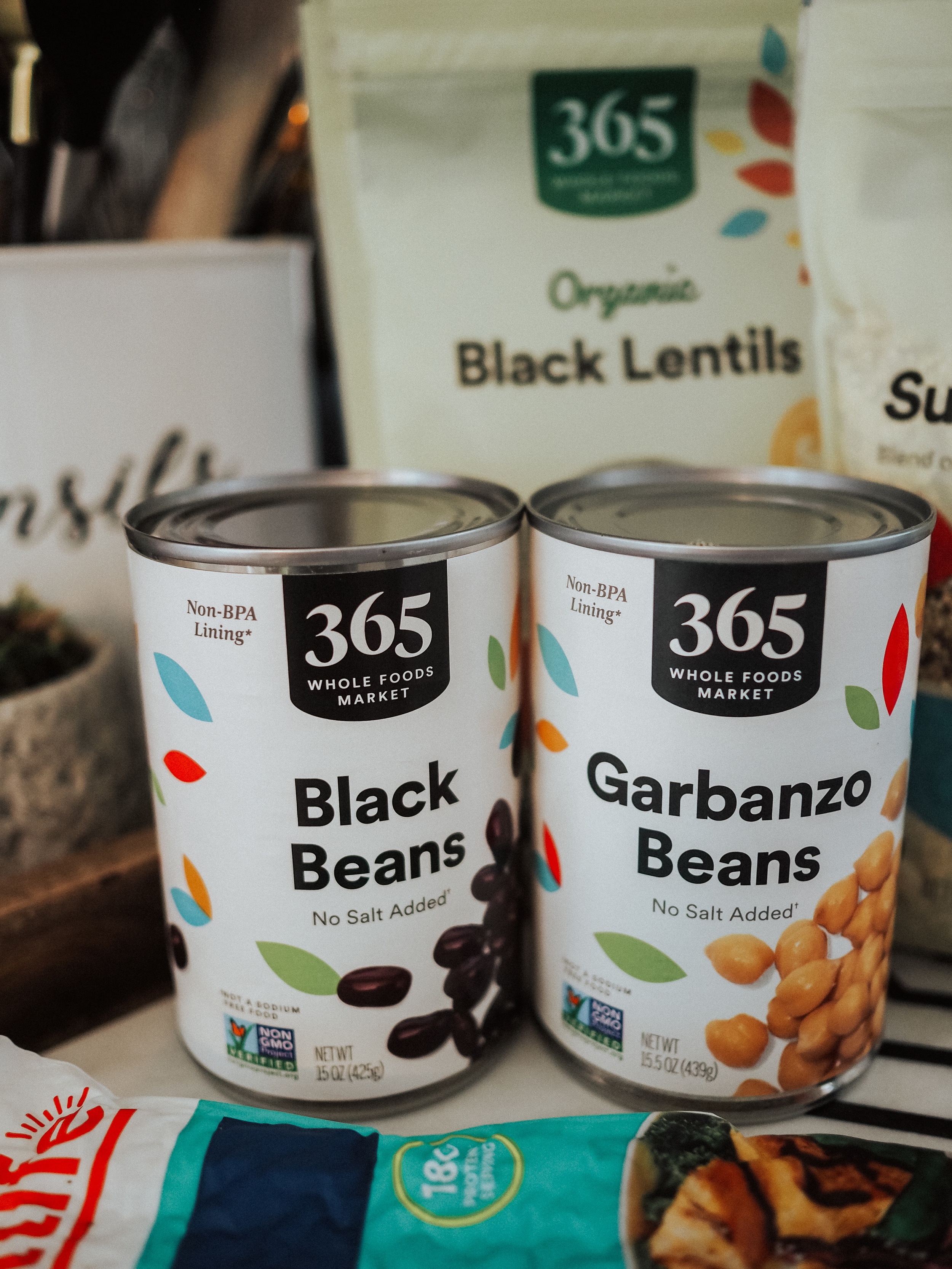I’ve flirted with being vegan for a couple of years now, and the whole plant based protein issue has been top of mind this entire time. It’s almost impossible to enter any everyday conversation about veganism and vegetarianism without discussing “the protein problem.” Essentially the argument is that vegans and vegetarians are likely to become protein deficient because of the lack of protein in plants compared to animals.
But like – let’s do some digging. Let’s potentially bust some myths. And let’s also give ya’ll a crazy good resource to refer to when trying to pick out the perfect plant based protein (or proteins!) for your meal.


Why I’m writing this post.
I love food. I also love animals and the planet. I personally think people choose to go vegan/vegetarian for two potential reasons: personal health and personal ethics. I’ve flirted with veganism because of some combination of the two.
The more important question is – how am I qualified to write this post? I’m a certified holistic health coach who believes in bio-individuality (what’s right for one person could be completely wrong for another). I love to explore different dietary theories, even if I don’t agree with them all. And most of all – I love to bust common dietary myths (you can catch some of this myth busting on my podcast).
Let’s kick this off with the big question – are vegans and vegetarians really more likely to be lacking in protein?
The tldr on this one is it depends. Vegans who are thoughtful in their meal planning and knowledgeable about how to eat a balanced plant based diet can ensure their protein intake is complete and adequate. Vegans who don’t have the knowledge (or the opportunity to gain the knowledge) may be at a disadvantage here.
Why meat eaters passionately believe meat is a better source of protein.
Meat eaters in the health industry believe meat is a better source of protein than plant proteins because meat is naturally a “complete” protein while plant based proteins are not “complete.” By “complete,” we mean the protein contains all the essential amino acids are bodies need. Meat eaters (understandably so) believe that because meat naturally contains all these amino acids are bodies need, meat is the superior source of protein.

Everything you need to know about complete proteins.
The essential amino acids.
Ready for a mouthful? The nine essential amino acids are Tryptophan, Threonine, Isoleucine, Leucine, Lysine, Methionine + Cystine, Phenylalanine + Tyrosine, Valine, and Histidine. I’m not a scientist and to be honest I’d bore you to death breaking down what each of these amino acids does for us. What I can say is they’re important. These nine essential amino acids are part of a healthy, balanced diet and ensuring your overall diet contains them all is important.
How to ensure you consume complete proteins when eating plant based protein.
Eating a plant based diet that is complete in proteins doesn’t have to be complicated – it just means being mindful. Generally, as long as you’re eating a variety of plant based foods throughout the day, you should be able to get the nutrients you need. The key is to eat colorfully and mix and match your plant based proteins at each meal (rice with beans, for example!).
If you’re wanting to get a little more nitty gritty and really ensure you’re completing your plant based proteins, try some of these combos:
- Rice and beans in a plant based Mexican inspired bowl, plate, or burrito. Rice is missing Threonine and Lysine, but beans contain both while missing Methionine (which rice has!)
- Whole grain bread with nut butter (this is my favorite health coach approved bread). Nut butters (like natural peanut butter) typically are missing Lysine, but Lysine is found in many whole grains.
- Chickpeas and seeds/nuts inside of a wrap, salad, or even curry. Chickpeas are missing Methionine, which seeds/nuts have. Seeds/nuts are often missing Lysine, which Chickpeas have.
By eating a variety of plants, you’re likely to be automatically filling in any missing nutrient gaps! For all you tofu haters out there – eating a plant based diet packed with protein doesn’t always have to be tofu-centric.
Fun fact: did you know Oreos are vegan? At the beginning of this blog post I clarified that people often go vegan for one of two reasons: ethics or health. For those of us that choose a vegan diet due to ethics, we sometimes can find ourselves eating vegan, but not healthfully. I’d absolutely agree with the meat eaters that vegans eating processed “junk” foods may be at risk for nutrient deficiencies. But I’d also argue the vegans that are keeping their plates diverse and colorful are likely getting plenty of protein.
The highest sources of plant based protein.
The great thing about plant based proteins are there are so many potential protein sources. Protein sneaks its way into a wide variety of plants. Here are some of my favorites – all packed with protein.
- edamame (18.46 grams per cup)
- lentils (17.86 grams per cup)
- chickpeas (14.53 grams per cup)
- quinoa (8.14 grams per cup)
- almonds (5.94 grams per ounce)
Reasons to eat more plants.
Notice I didn’t say reasons to go vegan or vegetarian. I’ll leave that up to you. Personally, I find that trying to sell meat eaters on the idea of dropping their meat cold turkey (lol – see what I did there) isn’t a great strategy. Most people don’t love the idea of deprivation. And most meat eaters feel really strongly about meat being the best source of protein for them. Because I believe in bio-individuality – I’m totally cool with that. But there are still plenty of reasons to add more plants to your plate.
Plants have low caloric density.
I talked about caloric density a ton in my Noom review blog post, but it’s worth a huge mention even if you’re not interested in any specific dietary programs. Caloric density refers to the amount of calories per weight. For example, grapes have a much lower caloric density than raisins. One pound of grapes will contain far fewer calories than one pound of raisins. Plants inherently have lower caloric density, often because they’re high in water content. Grapes, watermelon, apples, berries, lettuce, squash – all these colorful foods have low caloric density.
Lower caloric density foods often help you feel full longer because you’re able to eat in volume. Eating a pound of grapes will actually fill you up faster and keep you full longer than eating a pound of raisins.
Plants are packed with vitamins and minerals.
Plants have a wide variety of vitamins and minerals, many that are amazing for the body. Spinach, carrots, broccoli, garlic, etc all have great nutrient profiles. Eating colorfully (with a range of fruits and veggies on your plate) means soaking up vitamins and minerals often not found in other food groups.
Plants have fiber.
Fiber is your friend! Fiber keeps the body satiated and helps regulate the digestive system. Some surveys have shown that the average American diet is wildly deficient in fiber. Processed foods and meat, which do tend to make up the majority of the Standard American Diet, are notably lacking in fiber. Plants, on the other hand, are often packed with fiber.
Fiber is your friend. Plant foods can help you easily infuse more fiber into your diet – no supplements needed (unless your doctor tells you they are). Chia seeds, for example, are one of my favorite fibrous plant based protein sources to sneak into a breakfast smoothie. Chia seeds have a whopping 10g of dietary fiber per oz along with 4.7g of protein per oz.
Plant based diets tend to lead to less metabolic disease.
I suppose the jury’s out on this one a bit, but plenty of studies have shown that plant based diets often result in lower risk of metabolic diseases. On the flip side, consumption of red meat has sometimes been linked to heart disease amongst other diseases. I want to be clear: all foods can be part of a healthy, balanced diet. ALL foods. But it’s hard to deny from a health perspective that we should all be putting more plants on our plates and reducing our overall consumption of meat.

If you’re going to eat meat – and can afford to make choices – here are my recommendations.
Red meat consumption in excess – and of low quality – is often linked to increased risk of metabolic disease. But not all meat consumption is created equal (just like not all vegan diets are created equal). There is a huge difference in the health impact of a fast food burger vs a cut of grass fed organic beef. Having the ability to pick and choose how you consume your meat is a privileged conversation. Higher quality meat is often far more expensive. When reading the below, please note all we can do is simply make the best choices we can.
Choose grass fed & organic.
“A calories is not a calorie” is a phrase I’ve often seen throughout my nutrition and health focused reading. It’s a concept I honestly can really relate to and align with. Let’s think – is 100 calories of candy the “same” as 100 calories of salad? The salad is clearly more nutrient dense than the candy and undeniably better for our overall health.
A calorie is not a calorie.
The same concept could be applied to meat consumption. Opting for a McDonald’s burger is wildly different than the nutrients found in high quality, grass fed, organic beef. Yep – the “good stuff” is always considerably more expensive. If you can swing it, choose higher quality meats wherever possible.
Opt for lean proteins.
Can’t deny it – steak and pork are pretty darn tasty. But poultry like chicken is definitely more lean and often the healthier choice. Because red meat is generally linked with higher rates of metabolic disease, this is the meat to watch your portions with. A well seasoned and prepared chicken breast is lean, has all the complete proteins you need, and will keep you satiated.
Eat meat like the cavemen did.
Which was sparingly. Think about it – how hard hunting must have really been. How rare a successful hunt likely was. The reality is that our archaic ancestors were unlikely to have been eating meat three times a day. Meat was probably a big pain to acquire and wasn’t an everyday occurrence. Meat was likely more of a luxury. Plants were the everyday occurrence.
So my recommendation is to do as the ancestors did – have meat 1-2x a week rather than 2-3x a day.
Some studies have also shown the impact of meat being the exception rather than the rule on longevity. I’ll admit that one of the dietary theories I learned during my time in health coaching school that resonated with me the most was Blue Zones. The Blue Zones are areas around the world – five locations to be exact – where there is a dense population of centenarians (people who live to be over 100 years old). One of the common themes? Meat isn’t an everyday dietary staple. Blue Zones diets often consist primarily of plants and whole grains, with meat saved for more special occasions. The real world application of this might mean not indulging in bacon for breakfast, a turkey sandwich for lunch, and chicken breast for dinner – but rather having meat on Sundays and/or holidays.
The Blue Zones studies are definitely observational. There are other factors in these five locations that could contribute to longevity beyond reduced meat consumption – such as reduced screen time, increased everyday activity (lots of walking), family and social structures, etc. But it’s still undeniable that the minimal consumption of meat in these areas has had some level of influence on longevity.
Don’t take away – ADD.
I’m definitely not that person trying to push veganism on everyone I meet. I’m not even fully vegan myself. I just happen to know plans are incredibly good for me and try to eat more of them. That’s why my biggest piece of advice would be to focus on adding to your plate, rather than taking away. Instead of focusing on removing the animal protein from your diet and meals, focus on cooking with more plants and adding more fruits and veggies to your plate. Deprivation honestly never feels great. Typically when we try to take things away, out of our diet, labeling them as “bad” foods – we actually crave them more.
Are protein powders good for you?
If you’re looking to cram as much protein content into your diet as possible – sure, protein powders can be part of a healthy, balanced diet. Again, I believe in bio-individuality. But I also don’t personally think the average person needs protein powders. If eating a balanced, diverse diet, many people should be able to get sufficient amounts of protein naturally without the need for dietary supplements. If I reach for a protein powder to add a little extra zing to a smoothie, I typically try to opt for plant based protein powders with limited, easy to read ingredients. If I can’t understand the majority of the ingredients on the label (or pronounce them), I typically don’t purchase. I also personally don’t operate well on dairy (even though I LOVE it), so truly do try to stick to a vegan protein powder wherever possible.
Are plant based “meats” good for you?
Debatable. I’m actually personally not a fan of plant-based protein meat (such as veggie burgers, vegan “chicken nuggets” etc). I just don’t personally love one food masquerading as something else. Frequently there are also a ton of ingredients in these products that I can’t pronounce – which usually for me, is a no go. To each their own! If a vegan burger aligns with your ethics and feels like a healthy part of your diet – by all means, indulge. I’m just of the mindset I’d rather have the highest quality meat based burger possible every once in a blue moon rather than substitute with faux meat.
Going vegan? Been vegan before? Exploring the world of plant based proteins? Let’s chat in the comments below!
